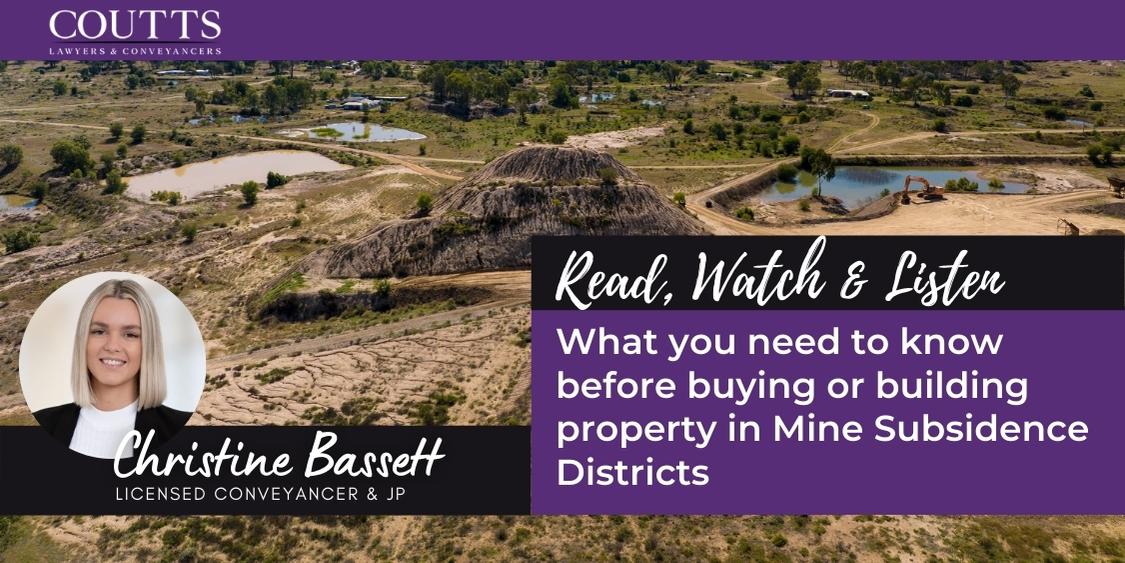KEY TAKE-OUTS
- What is a Mine Subsidence area?
- How do I know if my land is in a Mine Subsidence District?
- What does it mean for my purchase?
- What does it mean for my build?
What is a Mine Subsidence District?
A Mine Subsidence District in New South Wales is an area that has been proclaimed by the Subsidence Advisory New South Wales (SANSW) to have a potential subsidence (gradual caving in or sinking of land) risk from active or inactive underground coal mining.
What is the Subsidence Advisory NSW responsible for?
The duties of the Subsidence Advisory of New South Wales include:
- supporting the property owners living in areas when subsidence from underground coal mining may occur;
- providing advocacy support to owners affected by coal mines subsidence in NSW;
- management of compensation claims when damage occurs due to subsidence and supporting owners through the claims process; and
- regulating development within such Districts to help protects homes and structures from subsidence damage.
How to tell if your land is in a Mine Subsidence District
When you are considering purchasing land that may or may not be located in a Mine Subsidence District, your solicitor/conveyancer will review the Contract for Sale which will include a certificate from the local council which will disclose whether or not the land is in a Mine Subsidence District.
You can also search a property to see if it is in a Mine Subsidence District here.
Buying property in a Mine Subsidence District
Under Section 23(a) the Coal Mine Subsidence Compensation Act 2017, buyers have the right to withdraw from a contract of sale for a structure that does not comply with SANSW’s development requirements. SANSW also has discretion to determine to pay a claim for subsidence damage to a contravening development in circumstances where the failure to obtain the relevant approvals was not the fault of the property owner or where exceptional circumstances exist.
If a property owner can demonstrate they exercised due diligence (for example, sought proof of approval from vendor or council at the time of purchase but either due to an error, omission or malfeasance) were not alerted that the structure was a contravening development, SANSW may determine to consider the claim.
Prior to 30 September 2019 the Subsidence Advisory New South Wales provided a Section 15B or 15C certificate.
The Section 15B certificate confirmed that a property in a Mine Subsidence District had been constructed in accordance with development requirements and was eligible for compensation should the property be impacted by subsidence damage.
The Section 15C certificate identified if a claim for mine subsidence damage to a property had previously been paid or was pending. If a compensation claim for the damage has already been paid, no further claims can be paid for the same damage irrespective of whether repairs were completed.
A new online register of certificates issued under the Mine Subsidence Compensation Act 1961 is available here. The register allows users to search for a property to ascertain whether a Section 15B certificate has previously been issued and if so the date of issue.
All structures on the property at the date of issue of the last certificate are eligible for compensation should subsidence damage occur. Improvements constructed since the issue of the last certificate must have been built in accordance with SANSW’s requirements to be eligible for compensation.
In some cases, a certificate may have been issued recently for a property or no improvements have recently been constructed or altered and the prospective purchaser may be satisfied to proceed with the purchase based on this information given the age of structures on the property.
Requirements: Building in a Mine Subsidence Area
Land within a subsidence district must be built to an appropriate standard to ensure any subsidence risk and damage is reduced.
All development within a subsidence district must submit and have a building application approved by SANSW.
The SANSW can impose conditions and requirements such as:
- Use of certain building materials and construction methods;
- The size, height, and location of new structures; etc
The requirements and conditions may increase building costs and guidelines should be looked at prior to any land purchase in a Mine Subsidence District.
There is a list of Mine Subsidence guidelines on the SANSW website which sets out requirements for building in a specific subsidence district.
There is also a list of exemptions in relation to minor construction work that does not require approval from the SANSW.
ABOUT CHRISTINE BASSETT:

Christine is a Licensed Conveyancer and Justice of the Peace at Coutts’ Narellan office. Since joining Coutts Lawyers & Conveyancers in 2013, Christine quickly immersed her interest into property and has since completed studies of Conveyancing Law and Practice at Macquarie University; and is accredited with the Australian Institute of Conveyancers NSW.
For further information please don’t hesitate to contact:
Christine Bassett
Licensed Conveyancer & JP
info@couttslegal.com.au
1300 268 887
CONTACT COUTTS LAWYERS & CONVEYANCERS TODAY.
This blog is merely general and non-specific information on the subject matter and is not and should not be considered or relied on as legal advice. Coutts is not responsible for any cost, expense, loss or liability whatsoever in relation to this blog, including all or any reliance on this blog or use or application of this blog by you.



